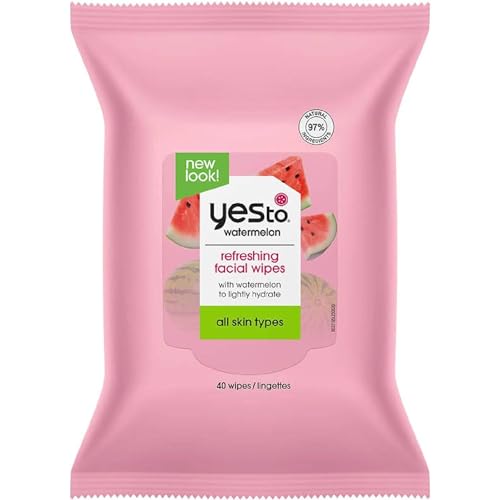
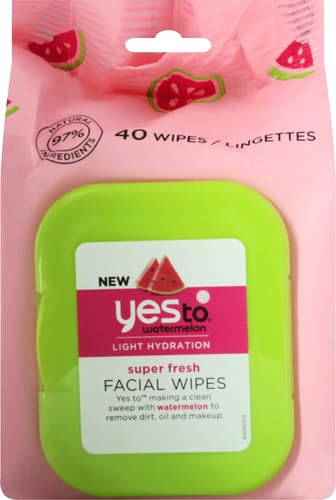
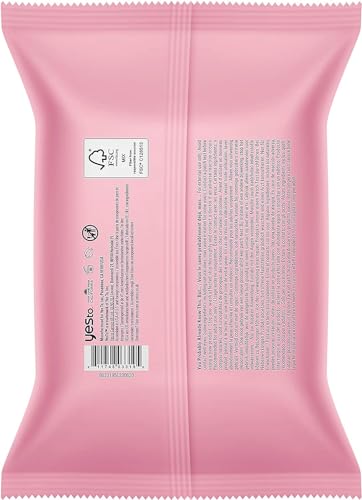




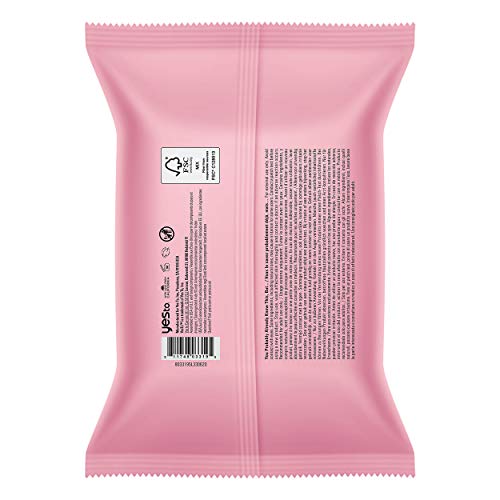



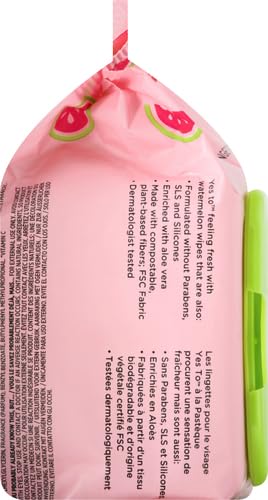
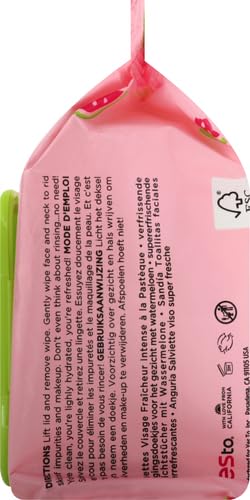
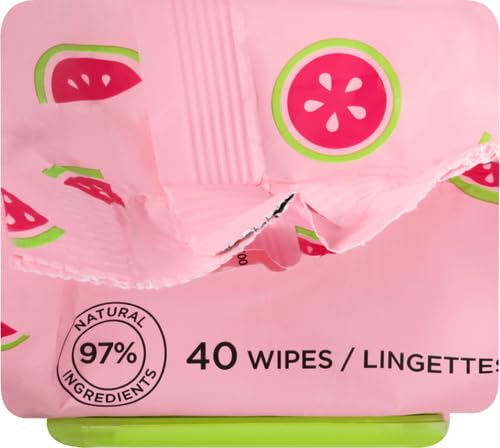
Yes To Facial Cleansing Wipes - Hydrating Makeup Remover with Watermelon & Aloe Vera - 1 Pack


Lilial
High RiskLilial (butylphenyl methylpropanal) is a synthetic fragrance ingredient commonly used in personal care and cosmetic products to provide a floral scent. It is known for its aromatic properties and is often included in formulations to enhance sensory appeal.
Sustai Insights
Lilial offers functional benefits as an effective fragrance component, enhancing the sensory experience of products. However, it poses significant health risks, including a high allergenic potential and concerns regarding endocrine disruption, despite lower risks for carcinogenicity and reproductive toxicity. Environmental risks include potential pollution and bioaccumulation. Regulatory bodies have raised concerns, resulting in high usage restrictions. Overall, the assessment indicates a high-risk level, suggesting caution in its use and consideration of safer or more sustainable alternatives.
Benzyl Benzoate
High RiskBenzyl benzoate is a compound commonly utilized as a solvent and preservative in various products. It is also used in formulations for its fragrance and as a potential anti-parasitic treatment in certain topical applications.
Sustai Insights
Benzyl benzoate serves effectively as a preservative and solvent, contributing to product stability. However, it presents a high risk of allergy and immunotoxicity while exhibiting low concerns for carcinogenicity and reproductive toxicity. Environmentally, it poses minimal ecotoxicological risks and is not bioaccumulative. Regulatory bodies have noted its restricted use in verified products, emphasizing caution. Overall, the ingredient is assessed as high risk, and safer alternatives should be considered for sensitive applications.
Fragrance
High RiskFragrance refers to a mixture of aromatic compounds used in products to provide scent. It is commonly listed as 'fragrance' or 'parfum' on product labels and can serve various functions, including enhancing user experience and masking undesirable odors.
Sustai Insights
Fragrance offers functional benefits by improving product appeal; however, it poses significant health risks, notably a high likelihood of causing allergies and allergic contact dermatitis. Environmental risks include potential pollution and endocrine disruption, though its overall carcinogenicity is low. Regulatory bodies have noted concerns regarding its use, leading to a high-risk classification. Safe usage practices should be observed, and alternatives such as natural essential oils are recommended for those sensitive to synthetic fragrances.
Benzyl Alcohol
High RiskBenzyl alcohol is a naturally occurring and synthetic aromatic alcohol commonly used as a solvent, preservative, and fragrance ingredient in various products. It is found in both plant sources and as a synthetic compound, functioning primarily to maintain product stability and enhance fragrance profiles.
Sustai Insights
Benzyl alcohol serves effectively as a preservative and solvent, contributing to product stability and sensory qualities. However, it poses potential health risks, particularly as an allergen, with high concern for immunotoxicity. Environmental risks include being a pollutant with low bioaccumulation potential. Regulatory agencies have established restrictions on its use in certain products. Overall, the risk level associated with benzyl alcohol is assessed as high, necessitating careful consideration of its use and potential alternatives.
Glycerin
Medium RiskGlycerin (also called glycerol) is a naturally occurring compound commonly used in personal care and cosmetic products. It functions as a humectant, attracting moisture to the skin, and is also utilized as a solvent and emollient to enhance product texture and stability.
Sustai Insights
Glycerin is valued for its effective moisturizing properties and biodegradability, making it a widely accepted ingredient in formulations. It poses low health risks, including low concerns for carcinogenicity and allergies. However, moderate use restrictions exist due to regulatory guidelines. While glycerin does not significantly contribute to environmental pollution, its production process should be ethically sourced. Overall, glycerin holds a medium risk level, emphasizing the importance of safe usage practices and considering sustainable alternatives.
Citric Acid
Medium RiskCitric acid is an alpha hydroxy acid used in personal care products primarily for its role as a pH adjuster and natural preservative. It occurs naturally in citrus fruits and is commonly utilized in various formulations for its chelating properties and mild exfoliation benefits.
Sustai Insights
Citric acid offers functional benefits as an effective preservative and pH stabilizer, contributing to product longevity and stability. It is biodegradable and derived from renewable sources. Health risks are low, with minimal concerns regarding carcinogenicity, allergies, and reproductive toxicity. However, moderate use restrictions exist due to potential irritation at high concentrations. Environmental risks are limited, as citric acid is not known to accumulate in ecosystems. Regulatory agencies have no significant advisories against its use. Overall, it is assessed as a medium-risk ingredient, with safe usage practices recommended and alternatives available.
Phenoxyethanol
Medium RiskPhenoxyethanol is a preservative used in cosmetics and personal care products to prevent microbial growth and extend shelf life. It is commonly found in formulations such as lotions, creams, and serums.
Sustai Insights
Phenoxyethanol serves effectively as a preservative, ensuring product stability and safety by inhibiting microbial growth. It is considered to have low health risks regarding carcinogenicity, allergies, and reproductive toxicity. However, moderate use restrictions exist, and regulatory bodies have advised caution in specific applications. Environmental concerns include its potential as a pollutant, although it is not highly bioaccumulative. Overall, the ingredient presents a medium risk level, with safe usage practices recommended and alternative preservatives available for those seeking greener options.
Sodium Benzoate
Medium RiskSodium benzoate is a preservative commonly used in food and cosmetic products to prevent microbial growth and extend shelf life. It is derived from benzoic acid and is effective at low concentrations, often used in acidic environments like beverages and condiments.
Sustai Insights
Sodium benzoate serves effectively as a preservative, contributing to product stability and safety. It is generally recognized as safe with low concerns for carcinogenicity, allergies, and reproductive toxicity, though it faces moderate use restrictions in some regions. Environmental risks include its potential as a pollutant, but it does not bioaccumulate significantly. Regulatory bodies have issued advisories regarding its concentration in products. Overall, the risk level is assessed as medium, with safe usage practices recommended. Alternatives such as potassium sorbate may provide similar benefits with potentially lower restrictions.
Potassium Sorbate
Medium RiskPotassium sorbate is a potassium salt of sorbic acid, primarily used as a preservative in food and cosmetic products. It inhibits the growth of molds, yeast, and some bacteria, extending the shelf life of products. It is commonly found in various formulations due to its effectiveness and low toxicity.
Sustai Insights
Potassium sorbate serves as an effective preservative, preventing microbial growth in food and cosmetic products, which is vital for safety and longevity. Although it has a low risk of carcinogenicity and developmental toxicity, there is a moderate concern regarding allergies and immunotoxicity. Environmentally, it poses minimal risks as it is not significantly bioaccumulative. Regulatory agencies have verified its use, although some products may face restrictions. Overall, it is assessed as a medium risk ingredient, with safe usage practices recommended, and alternatives such as natural preservatives could be considered.
Sodium Ascorbyl Phosphate
Low RiskSodium ascorbyl phosphate is a salt of ascorbic acid (vitamin C) commonly used in cosmetic formulations. It acts as an antioxidant and is often included for its ability to brighten skin and enhance the stability of products by preventing oxidation.
Sustai Insights
Sodium ascorbyl phosphate provides functional benefits as an antioxidant and skin-brightening agent, contributing to product efficacy. It is considered low risk regarding health impacts, with minimal concerns for carcinogenicity, allergies, or reproductive toxicity. Environmentally, it does not present significant hazards. Regulatory bodies do not impose severe restrictions, classifying it as safe for use. Overall, the risk level associated with this ingredient is low, making it a suitable choice in cosmetic formulations.
Citrullus Vulgaris (Watermelon) Fruit Extract
Low RiskCitrullus vulgaris (watermelon) fruit extract is derived from the watermelon fruit and is commonly used in cosmetic formulations for its hydrating and soothing properties. It contains vitamins, antioxidants, and amino acids, contributing to skin nourishment and moisture retention.
Sustai Insights
Citrullus vulgaris (watermelon) fruit extract offers functional benefits such as hydration and antioxidant protection, with low health concerns regarding carcinogenicity, allergies, and reproductive toxicity. Environmentally, it poses minimal risks with no significant pollutant or bioaccumulation potential. Regulatory bodies do not impose restrictions on its use. Overall, the ingredient is assessed as low risk, making it a favorable choice in skincare formulations. Alternatives include other fruit extracts with similar benefits, offering opportunities for innovation.
Butylphenyl
Low RiskButylphenyl is an organic compound primarily used in formulations for its effectiveness as a fragrance component. It serves to enhance the scent profile of various consumer products, including cosmetics and personal care items.
Sustai Insights
Butylphenyl offers functional benefits as a fragrance enhancer. It has a low risk profile regarding health concerns such as carcinogenicity, allergies, and reproductive toxicity, with no current restrictions from regulatory bodies. However, it may pose minor environmental risks, including potential pollutant status. Overall, the ingredient is assessed as low risk, with safe usage practices recommended. Safer alternatives exist for fragrance enhancement, promoting sustainability.
Ci 75125
Low RiskCI 75125 is a synthetic colorant commonly used in cosmetic and personal care products to provide coloration. It serves the primary function of enhancing the aesthetic appeal of products by imparting vibrant hues. Its use is regulated by the FDA and other authorities to ensure safety.
Sustai Insights
CI 75125 offers effective coloration benefits in various formulations without significant health risks, as assessments indicate low concerns for carcinogenicity, allergies, and reproductive toxicity. However, it may present environmental risks, such as potential pollution and bioaccumulation. Regulatory agencies have established usage restrictions to mitigate risks. Overall, the ingredient is considered low risk, with safe usage practices recommended. Alternatives include natural colorants derived from plants or minerals for those seeking sustainable options.
Ascorbic Acid (Vitamin C)
Low RiskAscorbic acid (Vitamin C) is a naturally occurring antioxidant essential for various biological functions, including collagen synthesis and immune response. It is commonly used in cosmetic and food products for its preservative properties and ability to enhance skin brightness.
Sustai Insights
Ascorbic acid provides functional benefits as an effective antioxidant and preservative, contributing to skin health and product stability. It is generally recognized as safe with low health risks, including minimal concerns for carcinogenicity and allergies. Environmentally, it poses low risks, as it is biodegradable and does not bioaccumulate. Regulatory bodies like the FDA have not imposed significant restrictions on its use. Overall, the ingredient presents a low risk, with safe usage practices ensuring consumer safety, and alternatives such as natural extracts exist for those seeking different formulations.
Krameria Triandra (Rhatany) Root Extract
Low RiskKrameria triandra (rhatany) root extract is derived from the roots of the Krameria triandra plant, commonly found in South America. It is primarily used in cosmetic formulations for its astringent and anti-inflammatory properties, contributing to skin soothing and conditioning.
Sustai Insights
Krameria triandra root extract offers functional benefits as a natural astringent and is noted for its low health risk profile, with minimal concerns regarding carcinogenicity, allergies, or reproductive toxicity. Environmentally, it poses low risk as a non-pollutant and non-bioaccumulative ingredient. Regulatory assessments indicate no significant restrictions. Overall, it holds a low-risk status, making it a suitable choice in formulations, although users should practice standard precautions. Alternatives such as witch hazel or green tea extract may offer similar benefits.
Decyl Glucoside
Low RiskDecyl glucoside is a glucose-based surfactant derived from natural sources, primarily used as a mild cleansing agent in personal care products. It effectively reduces surface tension, allowing for improved mixing of ingredients and enhanced cleansing properties without stripping natural oils from the skin.
Sustai Insights
Decyl glucoside offers functional benefits as a non-ionic surfactant, making it suitable for sensitive skin formulations. It is biodegradable and derived from renewable resources, supporting sustainability. Health risks are primarily low, with minimal concerns regarding irritation and allergies. Environmental risks are low, as it does not significantly contribute to pollution or bioaccumulation. Regulatory status is generally favorable, with low restrictions noted. Overall, decyl glucoside presents a low risk for use in consumer products, making it a suitable choice for gentle formulations.
Sorbitan Oleate Decylglucoside Crosspolymer
Low RiskSorbitan oleate decylglucoside crosspolymer is a synthetic polymer derived from sorbitan oleate and decylglucoside. It functions primarily as an emulsifier and thickening agent in cosmetic and personal care products, aiding in the stabilization of formulations and improving texture.
Sustai Insights
Sorbitan oleate decylglucoside crosspolymer offers functional benefits as an effective emulsifier and stabilizer, enhancing product consistency. It has low health risk concerns related to carcinogenicity, allergenic potential, and reproductive toxicity. Environmentally, it presents low bioaccumulation and pollution risks. Regulatory bodies do not impose restrictions on its use. Overall, its risk level is assessed as low, making it a suitable ingredient in formulations.
Water
Low RiskWater is a clear, colorless liquid essential for various biological processes. It serves as a solvent in formulations, facilitating the dissolution of other ingredients and enhancing product texture and application. Additionally, water plays a crucial role in hydration and is a key component in many cosmetic and personal care products.
Sustai Insights
Water is an effective solvent and hydrator, contributing to the texture and efficacy of formulations. It is biodegradable and generally regarded as safe, with low concerns regarding carcinogenicity, allergies, and reproductive toxicity. However, excessive water usage can lead to environmental concerns, particularly regarding resource depletion. Regulatory bodies do not impose restrictions on water use in cosmetics. Overall, the risks associated with water are low, making it a safe and essential ingredient.
Ethylhexylglycerin
Low RiskEthylhexylglycerin is a glyceryl ether utilized primarily as a skin-conditioning agent and preservative in cosmetic formulations. It enhances the efficacy of preservatives and serves as a humectant, helping to retain moisture in the skin. This ingredient is commonly found in various personal care products.
Sustai Insights
Ethylhexylglycerin offers functional benefits as an effective preservative and skin-conditioning agent, contributing to product longevity and moisture retention. Health risks are generally low, with minor concerns regarding allergic contact dermatitis and irritant potential. Environmentally, it poses minimal risks, not being recognized as a pollutant or bioaccumulative. Regulatory bodies have imposed few restrictions, indicating its safety for use. Overall, its risk level is assessed as low, making it a viable option in cosmetic formulations. For those seeking alternatives, ingredients like propanediol may serve similar functions with potentially lower irritation profiles.
Aloe Barbadensis (Aloe Vera) Leaf Juice
Low RiskAloe barbadensis (aloe vera) leaf juice is derived from the succulent aloe vera plant, known for its hydrating and soothing properties. It is commonly used in cosmetic formulations for its moisturizing effects and is often included in products aimed at skin care and healing.
Sustai Insights
Aloe vera leaf juice offers functional benefits as a moisturizer and skin soothing agent, while being sustainably sourced and biodegradable. Health risks are low, with minimal concerns regarding carcinogenicity, allergies, and reproductive toxicity. Environmental impact is also low, with no significant pollutants identified. Regulatory agencies impose few restrictions. Overall, the ingredient poses a low risk, making it a favorable choice in cosmetic formulations.
Sodium Ascorbyl Phosphate
Low RiskSodium ascorbyl phosphate is a salt of ascorbic acid (vitamin C) commonly used in cosmetic formulations. It acts as an antioxidant and is often included for its ability to brighten skin and enhance the stability of products by preventing oxidation.
Sustai Insights
Sodium ascorbyl phosphate provides functional benefits as an antioxidant and skin-brightening agent, contributing to product efficacy. It is considered low risk regarding health impacts, with minimal concerns for carcinogenicity, allergies, or reproductive toxicity. Environmentally, it does not present significant hazards. Regulatory bodies do not impose severe restrictions, classifying it as safe for use. Overall, the risk level associated with this ingredient is low, making it a suitable choice in cosmetic formulations.
Citrullus Vulgaris (Watermelon) Fruit Extract
Low RiskCitrullus vulgaris (watermelon) fruit extract is derived from the watermelon fruit and is commonly used in cosmetic formulations for its hydrating and soothing properties. It contains vitamins, antioxidants, and amino acids, contributing to skin nourishment and moisture retention.
Sustai Insights
Citrullus vulgaris (watermelon) fruit extract offers functional benefits such as hydration and antioxidant protection, with low health concerns regarding carcinogenicity, allergies, and reproductive toxicity. Environmentally, it poses minimal risks with no significant pollutant or bioaccumulation potential. Regulatory bodies do not impose restrictions on its use. Overall, the ingredient is assessed as low risk, making it a favorable choice in skincare formulations. Alternatives include other fruit extracts with similar benefits, offering opportunities for innovation.
Butylphenyl
Low RiskButylphenyl is an organic compound primarily used in formulations for its effectiveness as a fragrance component. It serves to enhance the scent profile of various consumer products, including cosmetics and personal care items.
Sustai Insights
Butylphenyl offers functional benefits as a fragrance enhancer. It has a low risk profile regarding health concerns such as carcinogenicity, allergies, and reproductive toxicity, with no current restrictions from regulatory bodies. However, it may pose minor environmental risks, including potential pollutant status. Overall, the ingredient is assessed as low risk, with safe usage practices recommended. Safer alternatives exist for fragrance enhancement, promoting sustainability.
Ci 75125
Low RiskCI 75125 is a synthetic colorant commonly used in cosmetic and personal care products to provide coloration. It serves the primary function of enhancing the aesthetic appeal of products by imparting vibrant hues. Its use is regulated by the FDA and other authorities to ensure safety.
Sustai Insights
CI 75125 offers effective coloration benefits in various formulations without significant health risks, as assessments indicate low concerns for carcinogenicity, allergies, and reproductive toxicity. However, it may present environmental risks, such as potential pollution and bioaccumulation. Regulatory agencies have established usage restrictions to mitigate risks. Overall, the ingredient is considered low risk, with safe usage practices recommended. Alternatives include natural colorants derived from plants or minerals for those seeking sustainable options.
Lilial
High RiskLilial (butylphenyl methylpropanal) is a synthetic fragrance ingredient commonly used in personal care and cosmetic products to provide a floral scent. It is known for its aromatic properties and is often included in formulations to enhance sensory appeal.
Sustai Insights
Lilial offers functional benefits as an effective fragrance component, enhancing the sensory experience of products. However, it poses significant health risks, including a high allergenic potential and concerns regarding endocrine disruption, despite lower risks for carcinogenicity and reproductive toxicity. Environmental risks include potential pollution and bioaccumulation. Regulatory bodies have raised concerns, resulting in high usage restrictions. Overall, the assessment indicates a high-risk level, suggesting caution in its use and consideration of safer or more sustainable alternatives.
Benzyl Benzoate
High RiskBenzyl benzoate is a compound commonly utilized as a solvent and preservative in various products. It is also used in formulations for its fragrance and as a potential anti-parasitic treatment in certain topical applications.
Sustai Insights
Benzyl benzoate serves effectively as a preservative and solvent, contributing to product stability. However, it presents a high risk of allergy and immunotoxicity while exhibiting low concerns for carcinogenicity and reproductive toxicity. Environmentally, it poses minimal ecotoxicological risks and is not bioaccumulative. Regulatory bodies have noted its restricted use in verified products, emphasizing caution. Overall, the ingredient is assessed as high risk, and safer alternatives should be considered for sensitive applications.
Ascorbic Acid (Vitamin C)
Low RiskAscorbic acid (Vitamin C) is a naturally occurring antioxidant essential for various biological functions, including collagen synthesis and immune response. It is commonly used in cosmetic and food products for its preservative properties and ability to enhance skin brightness.
Sustai Insights
Ascorbic acid provides functional benefits as an effective antioxidant and preservative, contributing to skin health and product stability. It is generally recognized as safe with low health risks, including minimal concerns for carcinogenicity and allergies. Environmentally, it poses low risks, as it is biodegradable and does not bioaccumulate. Regulatory bodies like the FDA have not imposed significant restrictions on its use. Overall, the ingredient presents a low risk, with safe usage practices ensuring consumer safety, and alternatives such as natural extracts exist for those seeking different formulations.
Krameria Triandra (Rhatany) Root Extract
Low RiskKrameria triandra (rhatany) root extract is derived from the roots of the Krameria triandra plant, commonly found in South America. It is primarily used in cosmetic formulations for its astringent and anti-inflammatory properties, contributing to skin soothing and conditioning.
Sustai Insights
Krameria triandra root extract offers functional benefits as a natural astringent and is noted for its low health risk profile, with minimal concerns regarding carcinogenicity, allergies, or reproductive toxicity. Environmentally, it poses low risk as a non-pollutant and non-bioaccumulative ingredient. Regulatory assessments indicate no significant restrictions. Overall, it holds a low-risk status, making it a suitable choice in formulations, although users should practice standard precautions. Alternatives such as witch hazel or green tea extract may offer similar benefits.
Decyl Glucoside
Low RiskDecyl glucoside is a glucose-based surfactant derived from natural sources, primarily used as a mild cleansing agent in personal care products. It effectively reduces surface tension, allowing for improved mixing of ingredients and enhanced cleansing properties without stripping natural oils from the skin.
Sustai Insights
Decyl glucoside offers functional benefits as a non-ionic surfactant, making it suitable for sensitive skin formulations. It is biodegradable and derived from renewable resources, supporting sustainability. Health risks are primarily low, with minimal concerns regarding irritation and allergies. Environmental risks are low, as it does not significantly contribute to pollution or bioaccumulation. Regulatory status is generally favorable, with low restrictions noted. Overall, decyl glucoside presents a low risk for use in consumer products, making it a suitable choice for gentle formulations.
Sorbitan Oleate Decylglucoside Crosspolymer
Low RiskSorbitan oleate decylglucoside crosspolymer is a synthetic polymer derived from sorbitan oleate and decylglucoside. It functions primarily as an emulsifier and thickening agent in cosmetic and personal care products, aiding in the stabilization of formulations and improving texture.
Sustai Insights
Sorbitan oleate decylglucoside crosspolymer offers functional benefits as an effective emulsifier and stabilizer, enhancing product consistency. It has low health risk concerns related to carcinogenicity, allergenic potential, and reproductive toxicity. Environmentally, it presents low bioaccumulation and pollution risks. Regulatory bodies do not impose restrictions on its use. Overall, its risk level is assessed as low, making it a suitable ingredient in formulations.
Water
Low RiskWater is a clear, colorless liquid essential for various biological processes. It serves as a solvent in formulations, facilitating the dissolution of other ingredients and enhancing product texture and application. Additionally, water plays a crucial role in hydration and is a key component in many cosmetic and personal care products.
Sustai Insights
Water is an effective solvent and hydrator, contributing to the texture and efficacy of formulations. It is biodegradable and generally regarded as safe, with low concerns regarding carcinogenicity, allergies, and reproductive toxicity. However, excessive water usage can lead to environmental concerns, particularly regarding resource depletion. Regulatory bodies do not impose restrictions on water use in cosmetics. Overall, the risks associated with water are low, making it a safe and essential ingredient.
Glycerin
Medium RiskGlycerin (also called glycerol) is a naturally occurring compound commonly used in personal care and cosmetic products. It functions as a humectant, attracting moisture to the skin, and is also utilized as a solvent and emollient to enhance product texture and stability.
Sustai Insights
Glycerin is valued for its effective moisturizing properties and biodegradability, making it a widely accepted ingredient in formulations. It poses low health risks, including low concerns for carcinogenicity and allergies. However, moderate use restrictions exist due to regulatory guidelines. While glycerin does not significantly contribute to environmental pollution, its production process should be ethically sourced. Overall, glycerin holds a medium risk level, emphasizing the importance of safe usage practices and considering sustainable alternatives.
Fragrance
High RiskFragrance refers to a mixture of aromatic compounds used in products to provide scent. It is commonly listed as 'fragrance' or 'parfum' on product labels and can serve various functions, including enhancing user experience and masking undesirable odors.
Sustai Insights
Fragrance offers functional benefits by improving product appeal; however, it poses significant health risks, notably a high likelihood of causing allergies and allergic contact dermatitis. Environmental risks include potential pollution and endocrine disruption, though its overall carcinogenicity is low. Regulatory bodies have noted concerns regarding its use, leading to a high-risk classification. Safe usage practices should be observed, and alternatives such as natural essential oils are recommended for those sensitive to synthetic fragrances.
Citric Acid
Medium RiskCitric acid is an alpha hydroxy acid used in personal care products primarily for its role as a pH adjuster and natural preservative. It occurs naturally in citrus fruits and is commonly utilized in various formulations for its chelating properties and mild exfoliation benefits.
Sustai Insights
Citric acid offers functional benefits as an effective preservative and pH stabilizer, contributing to product longevity and stability. It is biodegradable and derived from renewable sources. Health risks are low, with minimal concerns regarding carcinogenicity, allergies, and reproductive toxicity. However, moderate use restrictions exist due to potential irritation at high concentrations. Environmental risks are limited, as citric acid is not known to accumulate in ecosystems. Regulatory agencies have no significant advisories against its use. Overall, it is assessed as a medium-risk ingredient, with safe usage practices recommended and alternatives available.
Benzyl Alcohol
High RiskBenzyl alcohol is a naturally occurring and synthetic aromatic alcohol commonly used as a solvent, preservative, and fragrance ingredient in various products. It is found in both plant sources and as a synthetic compound, functioning primarily to maintain product stability and enhance fragrance profiles.
Sustai Insights
Benzyl alcohol serves effectively as a preservative and solvent, contributing to product stability and sensory qualities. However, it poses potential health risks, particularly as an allergen, with high concern for immunotoxicity. Environmental risks include being a pollutant with low bioaccumulation potential. Regulatory agencies have established restrictions on its use in certain products. Overall, the risk level associated with benzyl alcohol is assessed as high, necessitating careful consideration of its use and potential alternatives.
Phenoxyethanol
Medium RiskPhenoxyethanol is a preservative used in cosmetics and personal care products to prevent microbial growth and extend shelf life. It is commonly found in formulations such as lotions, creams, and serums.
Sustai Insights
Phenoxyethanol serves effectively as a preservative, ensuring product stability and safety by inhibiting microbial growth. It is considered to have low health risks regarding carcinogenicity, allergies, and reproductive toxicity. However, moderate use restrictions exist, and regulatory bodies have advised caution in specific applications. Environmental concerns include its potential as a pollutant, although it is not highly bioaccumulative. Overall, the ingredient presents a medium risk level, with safe usage practices recommended and alternative preservatives available for those seeking greener options.
Sodium Benzoate
Medium RiskSodium benzoate is a preservative commonly used in food and cosmetic products to prevent microbial growth and extend shelf life. It is derived from benzoic acid and is effective at low concentrations, often used in acidic environments like beverages and condiments.
Sustai Insights
Sodium benzoate serves effectively as a preservative, contributing to product stability and safety. It is generally recognized as safe with low concerns for carcinogenicity, allergies, and reproductive toxicity, though it faces moderate use restrictions in some regions. Environmental risks include its potential as a pollutant, but it does not bioaccumulate significantly. Regulatory bodies have issued advisories regarding its concentration in products. Overall, the risk level is assessed as medium, with safe usage practices recommended. Alternatives such as potassium sorbate may provide similar benefits with potentially lower restrictions.
Potassium Sorbate
Medium RiskPotassium sorbate is a potassium salt of sorbic acid, primarily used as a preservative in food and cosmetic products. It inhibits the growth of molds, yeast, and some bacteria, extending the shelf life of products. It is commonly found in various formulations due to its effectiveness and low toxicity.
Sustai Insights
Potassium sorbate serves as an effective preservative, preventing microbial growth in food and cosmetic products, which is vital for safety and longevity. Although it has a low risk of carcinogenicity and developmental toxicity, there is a moderate concern regarding allergies and immunotoxicity. Environmentally, it poses minimal risks as it is not significantly bioaccumulative. Regulatory agencies have verified its use, although some products may face restrictions. Overall, it is assessed as a medium risk ingredient, with safe usage practices recommended, and alternatives such as natural preservatives could be considered.
Ethylhexylglycerin
Low RiskEthylhexylglycerin is a glyceryl ether utilized primarily as a skin-conditioning agent and preservative in cosmetic formulations. It enhances the efficacy of preservatives and serves as a humectant, helping to retain moisture in the skin. This ingredient is commonly found in various personal care products.
Sustai Insights
Ethylhexylglycerin offers functional benefits as an effective preservative and skin-conditioning agent, contributing to product longevity and moisture retention. Health risks are generally low, with minor concerns regarding allergic contact dermatitis and irritant potential. Environmentally, it poses minimal risks, not being recognized as a pollutant or bioaccumulative. Regulatory bodies have imposed few restrictions, indicating its safety for use. Overall, its risk level is assessed as low, making it a viable option in cosmetic formulations. For those seeking alternatives, ingredients like propanediol may serve similar functions with potentially lower irritation profiles.
Aloe Barbadensis (Aloe Vera) Leaf Juice
Low RiskAloe barbadensis (aloe vera) leaf juice is derived from the succulent aloe vera plant, known for its hydrating and soothing properties. It is commonly used in cosmetic formulations for its moisturizing effects and is often included in products aimed at skin care and healing.
Sustai Insights
Aloe vera leaf juice offers functional benefits as a moisturizer and skin soothing agent, while being sustainably sourced and biodegradable. Health risks are low, with minimal concerns regarding carcinogenicity, allergies, and reproductive toxicity. Environmental impact is also low, with no significant pollutants identified. Regulatory agencies impose few restrictions. Overall, the ingredient poses a low risk, making it a favorable choice in cosmetic formulations.
Discover the refreshing power of Yes To Face Wipes, designed for both men and women. These dermatologist-tested facial cleansing wipes effectively hydrate while effortlessly removing makeup, dirt, and oil for a clean, revitalized face—perfect for on-the-go freshness.
- Hydration and Cleansing: Formulated with watermelon extract and soothing aloe vera, these wipes hydrate and cleanse, leaving skin looking brighter and smoother.
- All Skin Types: Ideal for every skin type, these antioxidant-rich wipes ensure all users experience refreshed skin without irritation.
- Convenient Use: Simply wipe your face and neck to remove impurities—no rinsing required—making them perfect for busy lifestyles or late nights.
- Natural Ingredients: With over 95% natural ingredients, these wipes are free from parabens, SLS, and silicones, ensuring a guilt-free skincare routine.
- Cruelty-Free Assurance: Proudly cruelty-free and Leaping Bunny certified, these wipes allow consumers to feel confident in their choice of ethical beauty products.
Subscribe & Save with Sustai
- Best Price Guarantee: Always enjoy the lowest prices on sustainable home essentials.
- No Surprises: We’ll notify you before shipping. No hidden fees, ever.
- You’re in Charge: Change, pause, or cancel your subscription anytime with ease.
- Eco-Friendly Deliveries: Our grouped shipments mean less packaging and lower emissions.
Join us on a sustainable journey. Special offers for a limited time! Prices and promotions may change.
Recommended Products
Discover the refreshing power of Yes To Face Wipes, designed for both men and women. These dermatologist-tested facial cleansing wipes effectively hydrate while effortlessly removing makeup, dirt, and oil for a clean, revitalized face—perfect for on-the-go freshness.
- Hydration and Cleansing: Formulated with watermelon extract and soothing aloe vera, these wipes hydrate and cleanse, leaving skin looking brighter and smoother.
- All Skin Types: Ideal for every skin type, these antioxidant-rich wipes ensure all users experience refreshed skin without irritation.
- Convenient Use: Simply wipe your face and neck to remove impurities—no rinsing required—making them perfect for busy lifestyles or late nights.
- Natural Ingredients: With over 95% natural ingredients, these wipes are free from parabens, SLS, and silicones, ensuring a guilt-free skincare routine.
- Cruelty-Free Assurance: Proudly cruelty-free and Leaping Bunny certified, these wipes allow consumers to feel confident in their choice of ethical beauty products.

You can have at most 2 Sustainable Steals products in your cart
Customer Reviews
Customers’ View
Customers generally appreciate the effectiveness and pleasant scent of Yes To's Facial Cleansing Wipes. Many users highlight the wipes' ability to quickly remove dirt, oil, and makeup, often noting their gentle nature and hydrating properties. One customer remarked, 'They leave my skin feeling soft and clean, and the best part is that they don’t cause an allergic reaction.' Additionally, the wipes are praised for their suitability for various skin types, although some users with oily skin have found them less effective. Importantly, the product is formulated with over 95% natural ingredients, aligning well with the values of health-conscious consumers. Overall, customers find these wipes to be a reliable and refreshing option for maintaining skin cleanliness on the go.
AI-generated from the text of customer reviewsThis product has no reviews yet.




